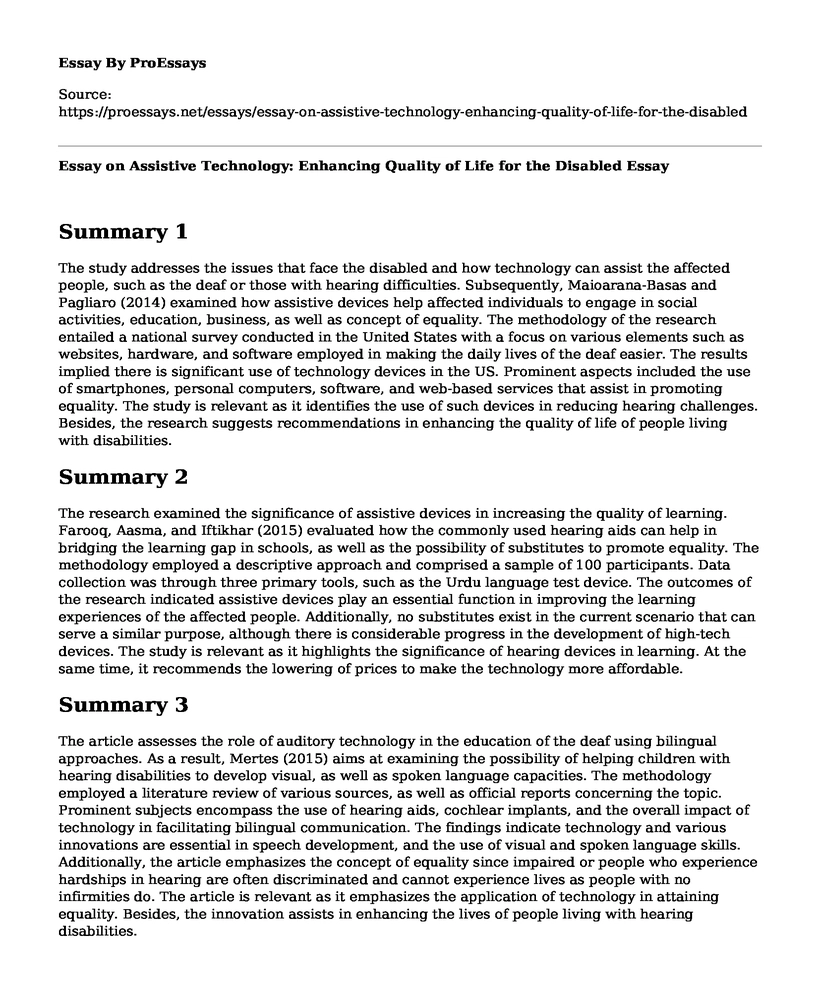Summary 1
The study addresses the issues that face the disabled and how technology can assist the affected people, such as the deaf or those with hearing difficulties. Subsequently, Maioarana-Basas and Pagliaro (2014) examined how assistive devices help affected individuals to engage in social activities, education, business, as well as concept of equality. The methodology of the research entailed a national survey conducted in the United States with a focus on various elements such as websites, hardware, and software employed in making the daily lives of the deaf easier. The results implied there is significant use of technology devices in the US. Prominent aspects included the use of smartphones, personal computers, software, and web-based services that assist in promoting equality. The study is relevant as it identifies the use of such devices in reducing hearing challenges. Besides, the research suggests recommendations in enhancing the quality of life of people living with disabilities.
Summary 2
The research examined the significance of assistive devices in increasing the quality of learning. Farooq, Aasma, and Iftikhar (2015) evaluated how the commonly used hearing aids can help in bridging the learning gap in schools, as well as the possibility of substitutes to promote equality. The methodology employed a descriptive approach and comprised a sample of 100 participants. Data collection was through three primary tools, such as the Urdu language test device. The outcomes of the research indicated assistive devices play an essential function in improving the learning experiences of the affected people. Additionally, no substitutes exist in the current scenario that can serve a similar purpose, although there is considerable progress in the development of high-tech devices. The study is relevant as it highlights the significance of hearing devices in learning. At the same time, it recommends the lowering of prices to make the technology more affordable.
Summary 3
The article assesses the role of auditory technology in the education of the deaf using bilingual approaches. As a result, Mertes (2015) aims at examining the possibility of helping children with hearing disabilities to develop visual, as well as spoken language capacities. The methodology employed a literature review of various sources, as well as official reports concerning the topic. Prominent subjects encompass the use of hearing aids, cochlear implants, and the overall impact of technology in facilitating bilingual communication. The findings indicate technology and various innovations are essential in speech development, and the use of visual and spoken language skills. Additionally, the article emphasizes the concept of equality since impaired or people who experience hardships in hearing are often discriminated and cannot experience lives as people with no infirmities do. The article is relevant as it emphasizes the application of technology in attaining equality. Besides, the innovation assists in enhancing the lives of people living with hearing disabilities.
Summary 4
The report is a recommendation by the Government Accountability Office, emphasizing the need for improving the lives of people affected by deafness and hearing issues. Subsequently, Scott (2011) aimed at examining how federal programs help children affected by the disability. The methodology used comprised of a literature review of existing sources, interviews with parents, educators, as well as state and federal officers. The findings indicate a significant number of the population have a disability. Moreover, such students receive their education in a variety of settings with insufficient specialized services. At the same time, government funds and input are not adequate in enhancing the learning conditions and quality of life of the deaf. The report is significant as it underscores the need for assistive devices and special education to meet the needs of the disabled. As well, the research highlights the statistics regarding the number of affected people, how such students receive their education, and challenges in meeting their learning needs for improved response.
References
Farooq, M. S. (2015). Learning through Assistive Devices: A Case of Students with Hearing Impairment. Bulletin of Education and Research, 37(1), 1-17. Retrieved from: https://files.eric.ed.gov/fulltext/EJ1210345.pdf
Maiorana-Basas, M., & Pagliaro, C. M. (2014). Technology use among adults who are deaf and hard of hearing: A national survey. Journal of Deaf Studies and Deaf Education, 19(3), 400-410. DOI: 10.1093/deafed/enu005.
Mertes, J. (2015). Auditory Technology and Its Impact on Bilingual Deaf Education. Odyssey: New Directions in Deaf Education, 16, 36-39. Retrieved from: http://www3.gallaudet.edu/Documents/Clerc/Odyssey/2015_issue/ODYSSEY_SPR2015_Mertes.pdf
Scott, G. A. (2011). Deaf and Hard of Hearing Children: Federal Support for Developing Language and Literacy. Report to Congressional Requesters. GAO-11-357. US Government Accountability Office. Retrieved from: https://www.gao.gov/new.items/d11357.pdf
Cite this page
Essay on Assistive Technology: Enhancing Quality of Life for the Disabled. (2023, Feb 12). Retrieved from https://proessays.net/essays/essay-on-assistive-technology-enhancing-quality-of-life-for-the-disabled
If you are the original author of this essay and no longer wish to have it published on the ProEssays website, please click below to request its removal:
- Essay on Science as a Human Endeavour Task - Transport Technology
- Research Paper on Dementia Disease State
- Infectious Diseases and Modern-Day Stressors Paper Example
- A) What effect is Anzaldua showing readers of mixing English and Spanish?
- Ethical Conflicts in the Medical Field - Essay Sample
- Essay Example on Fragmentation in US Healthcare System: Effects and Examples
- Essay Example on Caring for Traumatic Brain Injuries: Understanding Severity and Characteristics







